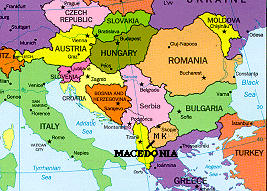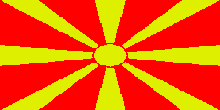

Macedonia at a glance
| Official name: | Republic of Macedonia |

|
| Population: | 2,102,000 |
| Density: | 212 per sq.mi. (82 per sq.km.) |
| Urban: | 54% |
| Capital: | Skopje (pop. 444,900) |
| Ethnic Groups: | Macedonians 67%, Albanians 21%, Turkish 4%, Serb 2% |
| Languages: | Macedonian, Albanian |
| Religions: | Eastern Orthodox 59%, Muslim 26%, Roman Catholic 4% |
| Life expectancy: | 75 female, 71 male |
| Literacy: | 89% |

|
| Government: | Republic |
| Parties: | see Political Parties in Macedonia |
| Suffrage: | Universal, over 18 |
| Memberships: | UN |
| Subdivisions: | 34 counties |

|
| GDP: | $ 2,200,000,000 |
| Per capita: | $ 1,010 |
| Monetary unit: | Denar |
| Trade partners: | Exports: Former Yugoslav Republics, Germany, Greece Imports: Former Yugoslav Republics, Grece, Albania |
| Exports: | manufactures, machinery and transportation equipment,food |
| Imports: | fuels and lubricants, manufactures, machinery and transportation equipment |


|
| Description: | Eastern Europe, landlocked |
| Area: | 9,928 sq.mi. (25,713 sq.km.) |
| Highest point: | Korab 9,035 ft. (2,754 m.) |
| Lowest point: | along Vardar River 165 ft. (50 m.) |

Brief Notes:
|
People: Most Macedonians are of Slavic background. Albanians are the most significant minority. Many Macedonians practice the Orthodox religion, although there is a significant Muslim minority in the western part of the country. Macedonians are proud of their folklore and traditional music. |
Economy and the Land:
Landlocked Macedonia is predominately mountaneous,
and most of the people are involved in agriculture
and herding. Agricultural products include cereal
grains, tobacco, and cotton. The country has
deposits of iron ore, lead, zinc, nickel, and
chromium, but there are no significant mineral fuels.
|
|
History and Politics:
The country of Macedonia is a part of a larger
historical region of the same name. Macedonia reached
its zenith under the rule of Alexander the Great, who
created a vast Macedonian empire in the fourth century
B.C. that extended from Egypt to northern India. The
empire fell apart after Alexander's death, and Rome
then conquered the region. The Slavic people, who were
the ancestors of today's Macedonians, migrated to the
area in the sixth century A.D. The region suffered
numerous invasions over the centuries. After 500 years
of Turkish rule, it was split between Serbia, Greece,
and Bulgaria in 1913, after serving as a battleground for
the two Balkan wars. In 1945, the Serbian portion of
Macedonia became a full and independent republic of
Yugoslavia. It remained part of Yugoslavia until 1991,
when it followed the lead of neighboring Yugoslav
republics and declared its independence. International
peacekeeping forces in Macedonia are attempting to prevent
a spillover of ethnic strife. Greece opposes use of the
name "Macedonia". U.S. and the European Union recognized
Macedonia in 1994.
|
copyright © Dusko Koncaliev
all rights reserved